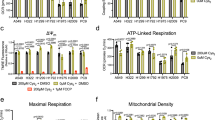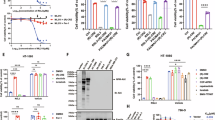Abstract
Ferroptosis is a form of regulated non-apoptotic cell death that has been implicated in several disease contexts. A better understanding of the ferroptotic death mechanism could lead to the development of new therapeutics for degenerative diseases, and a better understanding of how to induce ferroptosis in specific tumor contexts. We performed an unbiased genome-wide siRNA screen to find genetic suppressors of ferroptosis. We determined that loss of CARS, the cysteinyl-tRNA synthetase, suppresses ferroptosis induced by erastin, which inhibits the cystine–glutamate antiporter known as system xc−. Knockdown of CARS inhibited erastin-induced death by preventing the induction of lipid reactive oxygen species, without altering iron homeostasis. Knockdown of CARS led to the accumulation of cystathionine, a metabolite on the transsulfuration pathway, and upregulated genes associated with serine biosynthesis and transsulfuration. In addition, inhibition of the transsulfuration pathway resensitized cells to erastin, even after CARS knockdown. These studies demonstrate a new mechanism of resistance to ferroptosis and may lead to strategies for inducing and suppressing ferroptosis in diverse contexts.
Similar content being viewed by others
Log in or create a free account to read this content
Gain free access to this article, as well as selected content from this journal and more on nature.com
or
Abbreviations
- HD:
-
Huntington’s disease
- PVL:
-
periventricular leukomalacia
- GSH:
-
glutathione
- ROS:
-
reactive oxygen species
- GPX4:
-
glutathione peroxidase 4
- BSO:
-
bluthionine sulfoximine
- CARS:
-
cysteinyl-tRNA synthetase
- CSSG:
-
cysteine–glutathione disulfide
- PPG:
-
propargylglycine
- ATOC:
-
α-tocopherol
- DFOM:
-
deferoxamine
- CBS:
-
cystathionine β-synthase
References
Vila M, Przedborski S . Targeting programmed cell death in neurodegenerative diseases. Nat Rev Neurosci 2003; 4: 365–375.
Linkermann A, Skouta R, Himmerkus N, Mulay SR, Dewitz C, De Zen F et al. Synchronized renal tubular cell death involves ferroptosis. Proc Natl Acad Sci USA 2014; 111: 16836–16841.
Friedmann Angeli JP, Schneider M, Proneth B, Tyurina YY, Tyurin VA, Hammond VJ et al. Inactivation of the ferroptosis regulator Gpx4 triggers acute renal failure in mice. Nat Cell Biol 2014; 16: 1180–1191.
Skouta R, Dixon SJ, Wang J, Dunn DE, Orman M, Shimada K et al. Ferrostatins inhibit oxidative lipid damage and cell death in diverse disease models. J Am Chem Soc 2014; 136: 4551–4556.
Bannai S, Sato H, Ishii T, Sugita Y . Induction of cystine transport activity in human fibroblasts by oxygen. J Biol Chem 1989; 264: 18480–18484.
Yang WS, SriRamaratnam R, Welsch ME, Shimada K, Skouta R, Viswanathan VS et al. Regulation of ferroptotic cancer cell death by GPX4. Cell 2014; 156: 317–331.
Yang W, Stockwell B . Synthetic lethal screening identifies compounds activating iron-dependent, nonapoptotic cell death in oncogenic-RAS-harboring cancer cells. Chem Biol 2008; 15: 234–245.
Dolma S, Lessnick S, Hahn W, Stockwell B . Identification of genotype-selective antitumor agents using synthetic lethal chemical screening in engineered human tumor cells. Cancer Cell 2003; 3: 285–296.
Yagoda N, von Rechenberg M, Zaganjor E, Bauer A, Yang W, Fridman D et al. RAS-RAF-MEK-dependent oxidative cell death involving voltage-dependent anion channels. Nature 2007; 447: 864–868.
Louandre C, Ezzoukhry Z, Godin C, Barbare J-C, Mazière J-C, Chauffert B et al. Iron-dependent cell death of hepatocellular carcinoma cells exposed to sorafenib. Int J Cancer 2013; 133: 1732–1742.
Dixon SJ, Patel DN, Welsch M, Skouta R, Lee ED, Hayano M et al. Pharmacological inhibition of cystine-glutamate exchange induces endoplasmic reticulum stress and ferroptosis. eLife 2014; 3: e02523.
Dixon S, Lemberg K, Lamprecht M, Skouta R, Zaitsev E, Gleason C et al. Ferroptosis: an iron-dependent form of nonapoptotic cell death. Cell 2012; 149: 1060–1072.
Boutros M, Bras LP, Huber W . Analysis of cell-based RNAi screens. Genome Biol 2006; 7: R66.
Hahn WC, Counter CM, Lundberg AS, Beijersbergen RL, Brooks MW, Weinberg RA . Creation of human tumour cells with defined genetic elements. Nature 1999; 400: 464–468.
Yao P, Fox P . Aminoacyl-tRNA synthetases in medicine and disease. EMBO Mol Med 2013; 5: 332–343.
Abeles RH, Walsh CT . Acetylenic enzyme inactivators. Inactivation of gamma-cystathionase, in vitro and in vivo, by propargylglycine. J Am Chem Soc 1973; 95: 6124–6125.
Dickhout JG, Carlisle RE, Jerome DE, Mohammed-Ali Z, Jiang H, Yang G et al. Integrated stress response modulates cellular redox state via induction of cystathionine gamma-lyase: cross-talk between integrated stress response and thiol metabolism. J Biol Chem 2012; 287: 7603–7614.
Keller TL, Zocco D, Sundrud MS, Hendrick M, Edenius M, Yum J et al. Halofuginone and other febrifugine derivatives inhibit prolyl-tRNA synthetase. Nat Chem Biol 2012; 8: 311–317.
Guo M, Yang XL, Schimmel P . New functions of aminoacyl-tRNA synthetases beyond translation. Nat Rev Mol Cell Biol 2010; 11: 668–674.
Pereira CM, Oliveira CR . Glutamate toxicity on a PC12 cell line involves glutathione (GSH) depletion and oxidative stress. Free Radic Biol Med 1997; 23: 637–647.
Ishii T, Bannai S, Sugita Y . Mechanism of growth stimulation of L1210 cells by 2-mercaptoethanol in vitro. Role of the mixed disulfide of 2-mercaptoethanol and cysteine. J Biol Chem 1981; 256: 12387–12392.
Palii SS, Kays CE, Deval C, Bruhat A, Fafournoux P, Kilberg MS . Specificity of amino acid regulated gene expression: analysis of genes subjected to either complete or single amino acid deprivation. Amino Acids 2009; 37: 79–88.
Mason RP, Casu M, Butler N, Breda C, Campesan S, Clapp J et al. Glutathione peroxidase activity is neuroprotective in models of Huntington's disease. Nat Genet 2013; 45: 1249–1254.
Paul BD, Sbodio JI, Xu R, Vandiver MS, Cha JY, Snowman AM et al. Cystathionine gamma-lyase deficiency mediates neurodegeneration in Huntington's disease. Nature 2014; 509: 96–100.
Hurdle JG, O’Neill AJ, Chopra I . Prospects for aminoacyl-tRNA synthetase inhibitors as new antimicrobial agents. Antimicrob Agents Chemother 2005; 49: 4821–4833.
Acknowledgements
We acknowledge the assistance of Dr. Chi Yun and Janine Recio at the NYU RNAi core for advice and assistance with the RNAi screen, Dr. Jose Silva at Mount Sinai for reagents and assistance with LentiORF experiments and Dr. Christine Huang for help with mutagenesis experiments. The NYU RNAi core is supported by NIHA CI 5P30CA16087-31 and NYSTEM Contract C026719. MH was supported by NIH predoctoral training grant in cancer biology (CA009503). This research was funded by the Howard Hughes Medical Institute, National Institute of Health (5R01CA097061, 5R01GM085081, R01CA161061), and New York Stem Cell Science (C026715) to BRS. BRS is an Early Career Scientist of the Howard Hughes Medical Institute.
Author information
Authors and Affiliations
Corresponding author
Ethics declarations
Competing interests
The authors declare no conflict of interest.
Additional information
Edited by P Vendenabeele
Supplementary Information accompanies this paper on Cell Death and Differentiation website
Rights and permissions
About this article
Cite this article
Hayano, M., Yang, W., Corn, C. et al. Loss of cysteinyl-tRNA synthetase (CARS) induces the transsulfuration pathway and inhibits ferroptosis induced by cystine deprivation. Cell Death Differ 23, 270–278 (2016). https://doi.org/10.1038/cdd.2015.93
Received:
Revised:
Accepted:
Published:
Issue date:
DOI: https://doi.org/10.1038/cdd.2015.93
This article is cited by
-
A New Perspective in the Treatment of Ischemic Stroke: Ferroptosis
Neurochemical Research (2024)
-
The mechanism of ferroptosis and its related diseases
Molecular Biomedicine (2023)
-
Intermittent dietary methionine deprivation facilitates tumoral ferroptosis and synergizes with checkpoint blockade
Nature Communications (2023)
-
Microglia ferroptosis is regulated by SEC24B and contributes to neurodegeneration
Nature Neuroscience (2023)
-
Arg-tRNA synthetase links inflammatory metabolism to RNA splicing and nuclear trafficking via SRRM2
Nature Cell Biology (2023)



